Gibilisco S. Teach Yourself Electricity and Electronics
Подождите немного. Документ загружается.

realm of broadcasting and communications that still predominates in much of the world. But some
people are still fascinated by the fact that people can contact each other using wireless devices alone,
without the need for any human-made infrastructure other than an antenna at the source and an-
other antenna at the destination. The ionosphere returns shortwave signals to the earth’s surface,
and allows reliable global broadcasting and communication to take place today, just as it has since
the early 1900s.
Various commercially manufactured shortwave receivers are available. Most electronics stores
carry one or more models, along with antenna equipment, for a complete installation. Amateur
radio conventions, called “hamfests,” can be a good source of shortwave receiving equipment at bar-
gain prices. For information about events of this sort in your area, you can contact the American
Radio Relay League at www.arrl.org, or pay a visit to your local amateur radio club.
Security and Privacy
People are becoming more and more concerned about the security and privacy of electronic com-
munications, particularly wireless. When a wireless system is compromised, the intrusion is not de-
tected until harm has been done to the system or to its subscribers.
Wireless versus Wired
Wireless eavesdropping differs from conventional wiretapping in two fundamental ways. First, eaves-
dropping is easier to do in wireless systems than in hard-wired systems. Those old-fashioned hard-
wired phone sets might not always be convenient, but your privacy is more likely to be maintained
than in the case with a system that uses any form of wireless. Second, eavesdropping of a wireless
link is nigh impossible to physically detect, but a tap can usually be found in a hard-wired system.
If any portion of a communications link is done by wireless, then an eavesdropping receiver can
be positioned within range of the RF transmitting antenna (Fig. 32-6) and the signals intercepted.
The existence of a wireless tap has no effect on the electronic characteristics of any equipment in the
system.
Levels of Security
There are four levels of telecommunications security, ranging from zero (no security) to the most se-
cure connections technology allows.
No Security (Level 0): In a communications system with level 0 security, anyone can eavesdrop
on a connection at any time, provided they are willing to spend the money and time to obtain the
necessary equipment. Two examples of level 0 links are amateur radio and citizens band (CB) voice
communications.
Wire Equivalent Security (Level 1): An end-to-end hard-wired connection requires considerable
effort to tap, and sensitive detection apparatus can usually reveal the existence of any wiretap. A
communications system with level 1 security must have certain characteristics in order to be effective
and practical:
• The cost must be affordable.
• The system must be reasonably safe for transactions such as credit-card purchases.
• When network usage is heavy, the degree of privacy afforded to each subscriber should not
decrease, relative to the case when network usage is light.
Security and Privacy 561
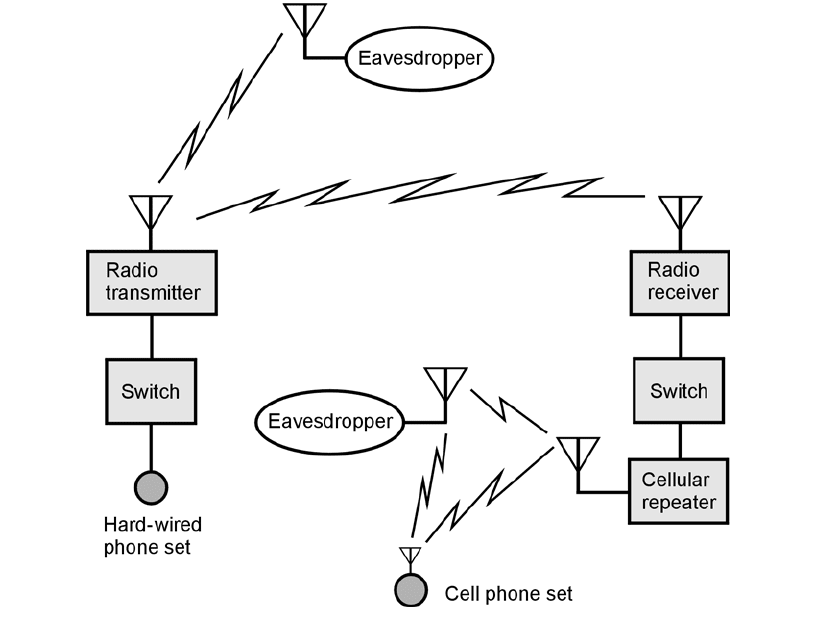
• Ciphers, if used, should be unbreakable for at least 12 months, and preferably for 24 months
or more.
• Encryption technology, if used, should be updated at least every 12 months, and preferably
every six months.
Security for Commercial Transactions (Level 2): Some financial and business data demands pro-
tection even beyond the wire equivalent level. Many companies and individuals refuse to transfer
money by electronic means because they fear criminals will gain access to an account. In a commu-
nications system with level 2 security, the encryption used in commercial transactions should be such
that it would take a potential intruder (also called a hacker) at least 10 years, and preferably 20 years
or more, to break the cipher. The technology should be updated at least every 10 years, but prefer-
ably every 3 to 5 years.
Military Level Security (Level 3): Security to military specifications (also called mil spec) involves
the most sophisticated encryption available. Technologically advanced countries, and entities with
economic power, have an advantage here. However, as technology gains ever more (and arguably too
much) power over human activities, aggressor nations and terrorists might injure powerful nations
by seeking out, and striking at, the weak points in communications infrastructures. In a communi-
562 Personal and Hobby Wireless
32-6 Eavesdropping on RF links in a telephone system. Heavy, straight lines
represent wires or cables; zigzag lines represent RF signals.
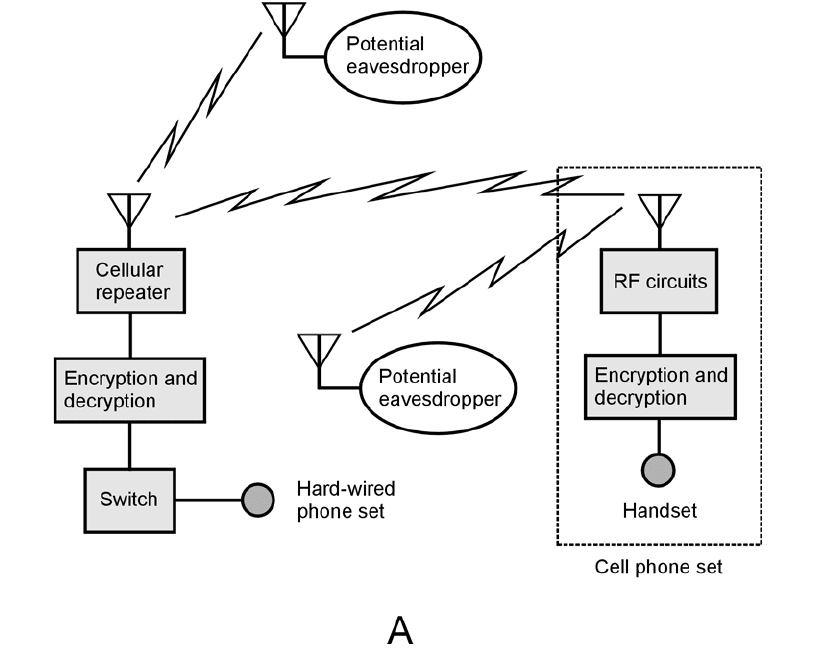
cations system with level 3 security, the encryption scheme should be such that engineers believe it
would take a hacker at least 20 years, and preferably 40 years or more, to break the cipher. The tech-
nology should be updated as often as economics allow.
Extent of Encryption
Security and privacy in wireless networks and communications systems can be achieved by means
of digital encryption. The idea is to render signals readable only to receivers with the necessary de-
cryption key. This makes it difficult for unauthorized people to gain access to the system.
For level 1 security, encryption is required only for the wireless portion(s) of the circuit. The ci-
pher should be changed at regular intervals to keep it fresh. The block diagram of Fig. 32-7A shows
wireless-only encryption for a hypothetical cellular telephone connection.
For security at levels 2 and 3, end-to-end encryption is necessary. The signal is encrypted at all in-
termediate points, even those for which signals are transmitted by wire or cable. Figure 32-7B shows
this scheme in place for the same hypothetical cellular connection as depicted at A.
Security and Privacy 563
32-7A Wireless-only encryption. Heavy, straight lines represent wires or cables; zigzag
lines represent RF signals.
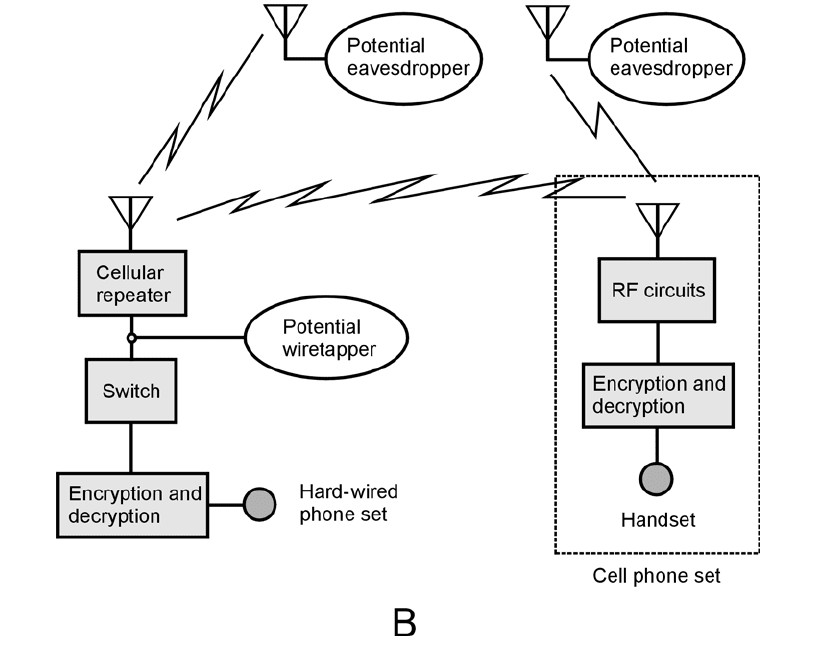
Security with Cordless Phones
Most cordless phones are designed to make it difficult for unauthorized people to pirate a telephone
line. Prevention of eavesdropping is a lower priority, except in expensive cordless systems. If there is
concern about using a cordless phone in a particular situation, a hard-wired phone set should be used.
If someone knows the frequencies at which a cordless handset and base unit operate, and if that
person is determined to eavesdrop on conversations that take place using that system, it is possible
to place a wireless tap on the line. The conversation can be intercepted at a point near the cordless
phone set and its base unit, and then transmitted to a remote site (Fig. 32-8) and recorded there.
Security with Cell Phones
Cellular telephones are, in effect, long-range cordless phones. The wider coverage of cellular re-
peaters, as compared with cordless base units, increases the risk of eavesdropping and unauthorized
use. Some cell phone vendors advertise their systems as “snoop proof.” Some of these claims have
more merit than others. The word “proof ” (meaning “immune”) should be regarded with skepti-
cism. Digital encryption is the most effective way to maintain privacy and security of cellular com-
munications. Nothing short of this is really of any use against a determined hacker.
564 Personal and Hobby Wireless
32-7B End-to-end encryption. Heavy, straight lines represent wires or cables; zigzag lines
represent RF signals.
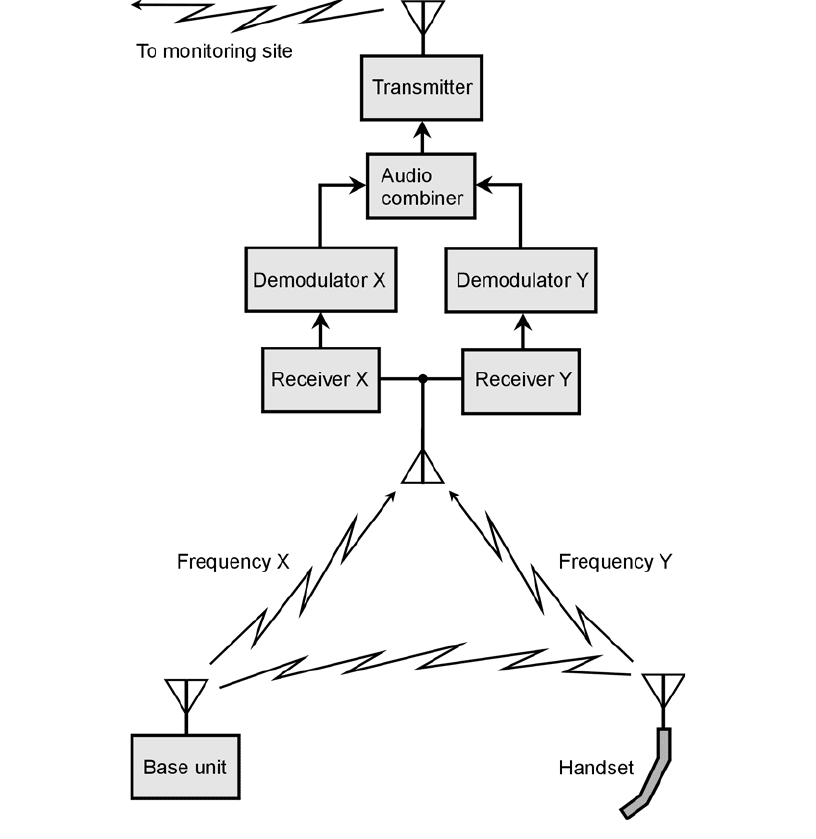
Security and Privacy 565
32-8 Wireless tapping of a cordless telephone.
Access and privacy codes, as well as data, must be encrypted if a cell phone system is to be max-
imally secure. If an unauthorized person knows the code with which a cell phone set accesses the sys-
tem (the “name” of the set), rogue cell phone sets can be programmed to fool the system into
thinking they belong to the user of the authorized set. This is known as cell phone cloning.
In addition to digital encryption of data, user identification (user ID) must be employed. The
simplest is a personal identification number (PIN). More sophisticated systems can employ voice-
pattern recognition, in which the phone set functions only when the designated user’s voice speaks
into it. Hand-print recognition, electronic fingerprinting, or iris-print recognition can also be em-
ployed. These are examples of biometric security measures.
Quiz
Refer to the text in this chapter if necessary. A good score is 18 correct. Answers are in the back of
the book.
1. A network that employs one central computer and multiple personal computers is called
(a) a wireless network.
(b) a local area network.
(c) a client-server network.
(d) a peer-to-peer network.
2. In order for a receiver to render a digitally encrypted signal intelligible, that receiver must
(a) have a directional antenna.
(b) have a biometric security system.
(c) have a decryption key.
(d) be licensed by the government.
3. Which of the following devices or systems is not wireless?
(a) An SWL station
(b) An amateur radio station
(c) A cordless phone set
(d) A computer with a telephone modem
4. Eavesdropping of a wireless link
(a) requires digital encryption.
(b) requires a decryption key.
(c) is difficult or impossible to detect.
(d) includes all of the above.
5. In the United States, a license is required for
(a) using a receiver on amateur radio frequencies.
(b) transmitting on amateur radio frequencies.
(c) using cordless phone sets.
(d) using cell phone sets.
6. In a LEO satellite system, the repeaters are located
(a) in space.
(b) at strategic locations in most countries of the world.
(c) at the north and south geographic poles.
(d) over the equator.
7. In a geostationary satellite link, the repeater is located
(a) on a buoy in the ocean.
(b) at strategic locations in most countries of the world.
(c) at the north and south geographic poles.
(d) over the equator.
566 Personal and Hobby Wireless
8. The term shortwave, in reference to radio, refers to signals having wavelengths of
approximately
(a) 10 mm to 100 mm.
(b) 100 mm to 1 m.
(c) 1 m to 10 m.
(d) 10 m to 100 m.
9. Which of the following is illegal to do in the United States using a ham radio station?
(a) Advertise used cars for sale
(b) Transmit Morse code
(c) Receive outside the amateur radio bands
(d) Receive signals without a license
10. A file server is
(a) a sensitive radio receiver equipped with D/A conversion.
(b) a radio transmitter equipped with digital signal processing (DSP).
(c) a central computer in a local area network.
(d) a repeater in a LEO satellite system.
11. A device consisting of a receiver and transmitter in the same case or enclosure, and commonly
used for wireless communications, is called
(a) a file server.
(b) a transceiver.
(c) a transverter.
(d) an encoder/decoder.
12. End-to-end encryption provides
(a) maximum range in a wireless LAN.
(b) a higher degree of security than wireless-only encryption.
(c) simultaneous transmission and reception in an amateur radio station.
(d) an easy means for hackers to clone cell phone sets.
13. A LAN in which each computer has more or less equal status, and in which each computer
stores its own data, is known as a
(a) wireless router.
(b) wide-area LAN.
(c) LAN topology.
(d) peer-to-peer LAN.
14. With respect to security, the term mil spec refers to
(a) wireless-only encryption.
(b) a peer-to-peer network.
(c) the use of a wireless router.
(d) the highest obtainable level of security.
Quiz 567
15. A radio signal is considered to be in the shortwave band if its frequency is which of the
following:
(a) 5 MHz
(b) 50 MHz
(c) 500 MHz
(d) Any of the above
16. In a cellular network, the region covered by a single base station is called a
(a) zone.
(b) cell.
(c) radius.
(d) link.
17. An advantage of a conventional hard-wired telephone over a cell phone is the fact that a hard-
wired phone set
(a) affords better privacy.
(b) offers greater portability.
(c) is more convenient for use around the house.
(d) employs digital encryption.
18. An advantage of a cell phone over a hard-wired phone is the fact that a cell phone set
(a) affords better privacy.
(b) costs less.
(c) offers better mobility.
(d) provides higher data speed.
19. In a two-way communications system with full duplex,
(a) either party can hear the other at all times.
(b) a cell phone transmits on two frequencies at the same time.
(c) end-to-end encryption is necessary.
(d) a file server or router is necessary.
20. An advantage of LEO satellite systems over geostationary satellite systems is the fact that
(a) the latency is much greater with LEO satellite systems.
(b) the equatorial regions are covered by LEO satellite systems, but not by geostationary
satellite systems.
(c) the regions near the geographic poles are covered by LEO satellite systems, but not by
geostationary satellite systems.
(d) All of the above are advantages of LEO satellite systems over geostationary satellite
systems.
568 Personal and Hobby Wireless
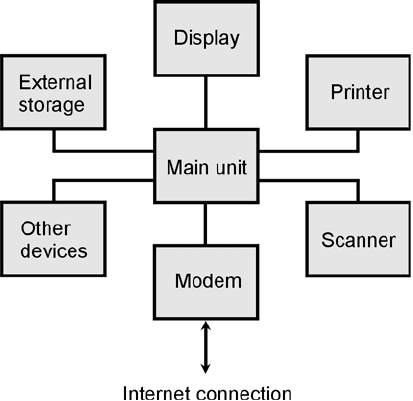
COMPUTERS ARE USED FOR CALCULATIONS, COMMUNICATIONS, WORD PROCESSING, DATA PROCESSING,
drawing, photo processing, music composition and editing, location, navigation, information
searches, robot control, and many other purposes. Figure 33-1 is a block diagram showing the major
parts of a typical computer system used in a home or small business.
569
33
CHAPTER
A Computer and
Internet Primer
33-1 Components of a
basic computer system
for personal or small
business use.
The Central Processing Unit
The microprocessor is the IC, or chip, that forms the core of your computer’s “brain.” It coordinates
all the action and does all the calculations. It is located on the motherboard, or main circuit board.
This board is sometimes called the logic board. The microprocessor, together with various other cir-
cuits, comprises the central processing unit (CPU). Auxiliary circuits can be fabricated onto the same
Copyright © 2006, 2002, 1997, 1993 by The McGraw-Hill Companies, Inc. Click here for terms of use.
chip as the microprocessor, but they are often separate. The external chips contain memory, storage,
and programming instructions.
You might think of the microprocessor as the computer’s conscious mind, which directs the
behavior of the machine by deliberate control. The CPU, controlled by the microprocessor, repre-
sents the PC’s entire mind, conscious and subconscious. All the ancillary circuits, in conjunction
with the CPU, make up the nervous system. Peripherals such as printers, disk drives, mice, speech
recognition/synthesis apparatus, modems, and displays are the hands, ears, eyes, and mouth of the
system. In advanced computer systems there can also be robots, vision systems, various home ap-
pliances, surveillance apparatus, medical devices, and other exotic equipment under the control of
the CPU.
Units of Digital Data
You learned about bits and bytes in Chap. 26. Let’s examine them again in more detail, with em-
phasis on their relevance to computers. Recall that one bit (1 b) is a single binary digit, and one byte
(1 B) is a unit of digital data consisting of a string of eight contiguous bits (8 b) in most systems.
One byte constitutes roughly the same amount of data as one character, such as a letter, numeral,
punctuation mark, or space.
Memory and Storage Capacity
Computer memory and storage involves files that are huge in terms of bytes. Therefore, kilobytes
(units of 2
10
= 1024 bytes), megabytes (units of 2
20
= 1,048,576 bytes), and gigabytes (units of 2
30
=
1,073,741,824 bytes) are used. The abbreviations for these units are KB, MB, and GB, respectively.
Alternatively you might see them abbreviated as K, M, and G.
As computer technology advances, you’ll hear more and more about a unit of data called a ter-
abyte (TB or T). This is equivalent to 2
40
bytes, or 1,048,576 MB. Someday we will commonly use
the terms petabyte (PB or P), which refers to 2
50
bytes or 1,048,576 GB, and exabyte (EB or E),
which refers to 2
60
bytes or 1,048,576 TB.
Here are all these data units listed as a hierarchy:
1 KB = 1024 B
1 MB = 1024 KB
1 GB = 1024 MB
1 TB = 1024 GB
1 PB = 1024 TB
1 EB = 1024 PB
Computer memory is usually specified in megabytes or gigabytes. The same holds true for re-
movable data storage media. The hard drive in a computer generally has capacity measured in giga-
bytes, although a few get into the terabyte range. Some external storage media, used for data
archiving (saving it for long-term reference), have capacity measured in terabytes and petabytes.
Data Speed
The speed at which computers send digital data to and from each other is almost always expressed
in bits per second (bps) and large multiples thereof. Multiples of bits per second involve the same pre-
570 A Computer and Internet Primer
